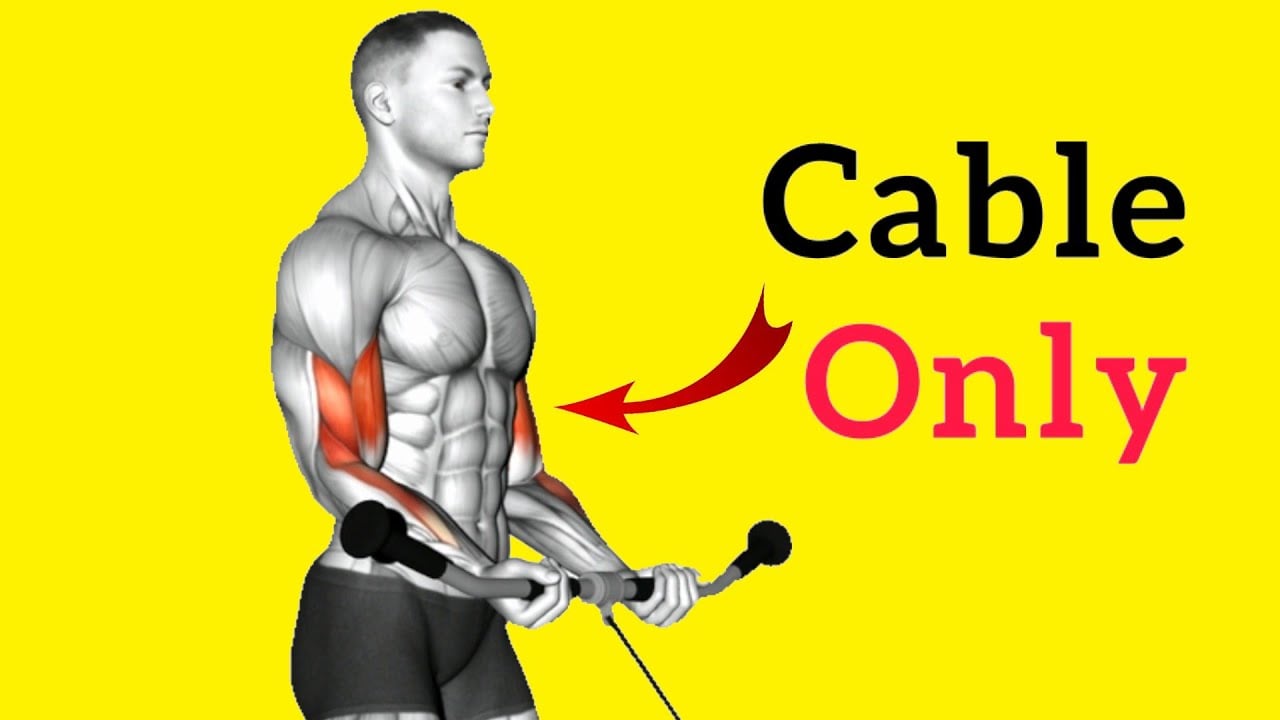The cable curl is a well-known biceps exercise that helps build a bigger and stronger arm. This isolation exercise works primarily on your biceps and trains the muscles in your forearms.
Why are cable curls so vital? Cable curls have many advantages over traditional bicep curls.
One of the benefits of cable curls is their consistent tension throughout the entire range of motion. Unlike free weights, which can sometimes lose resistance at certain points, the cable machine ensures your biceps are constantly engaged.
It is one of my favorite bicep exercises because it allows me to lift heavy with ease of joint movement and provides smooth control.
There are many variations of cable curl that you can add to your bicep workout routine, and all have their own unique benefits.
- Standing Cable Curls: Allow greater range of motion and involvement of core/legs to stabilize.
- Seated Cable Curls: Isolating the biceps and preventing momentum from taking over.
- Single Arm Cable Curls: Prevent imbalance and allow each arm to work independently. Unilateral training.
- Close Grip Cable Curls: These are good to target the short bicep head.
- Wide Grip Cable Curls: Emphasize the long bicep head.
Use Our Free Calculator To Know Your Calories Requirement To Gain Muscle Mass
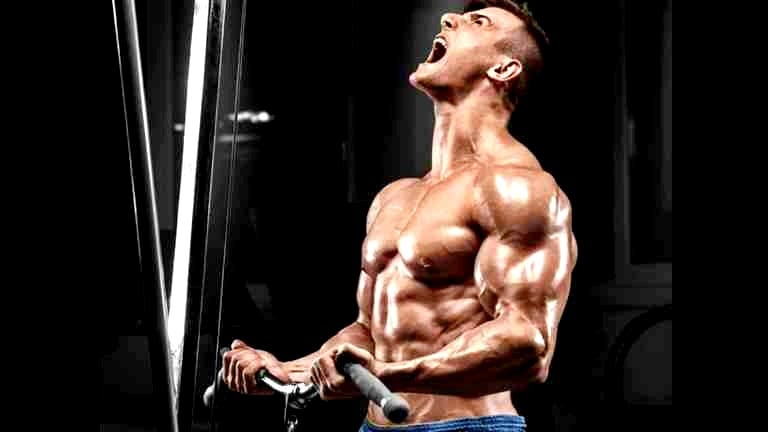
- Cable Curl Muscles Worked
- Bicep Brachii
- Brachialis
- Brachioradialis
- How To Do Cable Bicep Curl
- Cable Bicep Curl Proper Form And Technique
- Cable Bicep Curl Variations
- 1. One Arm Cable Curl
- 2. Close Grip Bicep Cable Curl
- 3. Wide Grip Cable Curl
- 4. Cable Hammer Curl
- 5. Cable Reverse Curl
- 6. High Cable Curl
- FAQs
- Are cable curls good?
- Why are cable curls so good?
- Do cable curls target short or long heads?
- Are cable curls push or pull?
Cable Curl Muscles Worked
The Cable curl, primarily works the biceps brachii. A handful of other muscles work or play the role of stabilizer muscles, including your brachialis, brachioradialis, and forearm muscles.
The bicep curl has the involvement of several synergist muscles, these muscles include, oblique and core muscles.
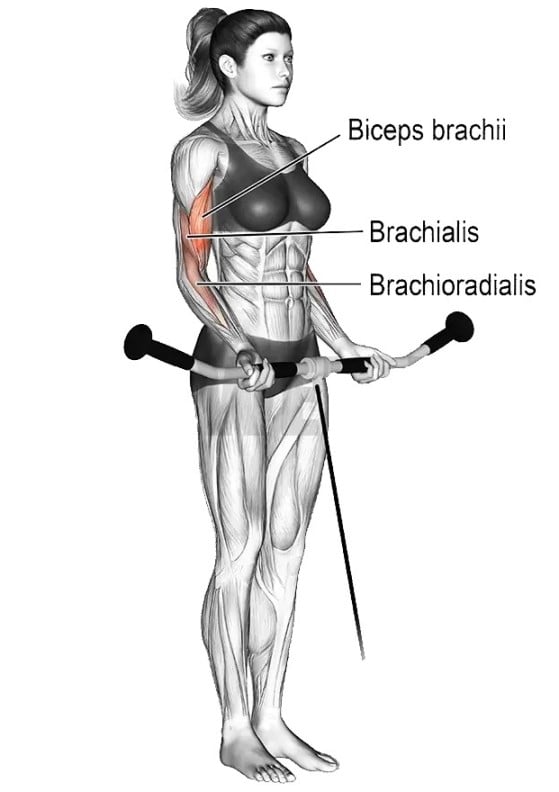
Bicep Brachii
The Biceps is a large, thick muscle of the upper arm. It has two heads: short (inner) and long (outer).
- The short head is located along the inner side of the anterior upper arm. It contributes to the biceps’ width.
- The long head is located along the outer side of the anterior upper arm. It comprises the majority of the biceps’ peak.
Brachialis
The brachialis is a muscle located underneath the biceps brachii. It is primarily responsible for elbow flexion.
Brachioradialis
The brachioradialis is a forearm muscle that runs along the outer side of the forearm. It assists in elbow flexion and plays a secondary role during the cable curl.
How To Do Cable Bicep Curl
- Attach a straight bar to the low pulley of a cable machine.
- Stand facing the cable machine with your feet shoulder-width apart.
- Grasp the bar with an underhand grip, hands shoulder-width apart.
- Stand tall with your back straight, shoulders relaxed, and elbows fully extended.
- Slowly curl the bar up towards your shoulders.
- Squeeze your biceps at the top of the movement.
- Slowly lower the bar back to the starting position.
- Complete the desired number of reps and sets.
- Use an appropriate weight that fatigues the biceps in 8–12 reps.
- Maintain good posture. Do not swing or use momentum – use controlled form.
Know More: 15 Best Biceps Exercises With Dumbbells For Mass & Strength
Cable Bicep Curl Proper Form And Technique
- Don’t lift the weight with too much momentum or swing your body.
- Don’t underestimate the pause at the top of your curl, and take a moment to squeeze your bicep when you get there.
- A slow, controlled descent will increase the time under tension, leading to more effective sets and a reduced risk of injury.
- Ensure that your elbows are kept close to your sides with your knees slightly bent.
- Always select a weight that gives you full control of your body.
- Don’t let your shoulders shrug up towards your ears.
- Incorporate proper warm-ups, rest, and nutrition into your exercise program.
- Rest for 24 to 48 hours before training the same muscle groups to allow sufficient recovery.
- Perform this exercise in a slow, controlled manner for best results.
- Don’t go heavy. Choose a lighter weight and focus on perfecting your form.
- Select the set, reps, and frequency for the cable bicep curl per your fitness level.
| Level | Sets | Reps | Frequency |
|---|---|---|---|
| Beginner | 2-3 | 8-12 | 1-2 times per week |
| Intermediate | 3-4 | 8-12 | 2-3 times per week |
| Advanced | 4-5 | 8-15 | 2-3 times per week |
Cable Bicep Curl Variations
Here are some of the best variations of cable curls that help you target different areas of your biceps and forearms.
1. One Arm Cable Curl
The one-arm cable curl is a unilateral bicep exercise that targets and isolates one arm at a time.
When doing a bicep workout with a cable machine, you can add plenty of single-arm exercises to correct potential imbalances.
If there’s an imbalance between your left and right biceps, cable one-arm curls can help correct it. Since each arm works independently, you can identify and address strength disparities between the sides.
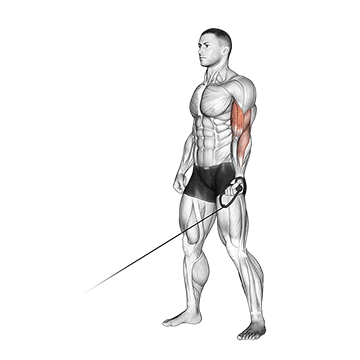
How To Do
- Single-handle attachment attached to a low-to-mid pulley.
- Grasp the stirrup with an underhand grip (palms facing up).
- Keep your elbow close to your side and curl the weight towards your shoulder.
- Pause at the peak of the contraction, then slowly lower the weight back to the starting position.
- Repeat for the desired number of repetitions, then switch to the other arm.
2. Close Grip Bicep Cable Curl
The close grip bicep cable curl is one of the best isolation exercises for the long head of the bicep. In this exercise, the hands are placed close together on the handle.
Unlike barbell or dumbbell curls, where the resistance varies during the lift, the cable pulley provides a uniform resistance throughout the movement.
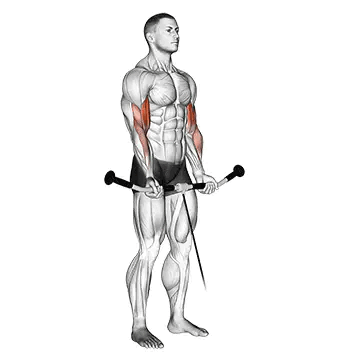
How To Do
- Set up the cable curl by attaching a straight bar to the low pulley cable.
- Grasp the bar with an underhand grip (palms facing up), and your hands should be narrower than shoulder-width apart.
- Curl the bar up toward your shoulders.
- Pause at the top of the contraction, then slowly lower the bar back to the starting position.
3. Wide Grip Cable Curl
A cable wide grip curl is a biceps isolation exercise that emphasizes the short head and give your biceps more width.
For those with wrist sensitivities, the wide grip can be more comfortable than a narrow grip, as it places less stress on the wrists while maximizing bicep engagement.
It also allows you to use heavier weights than a narrower grip curl.
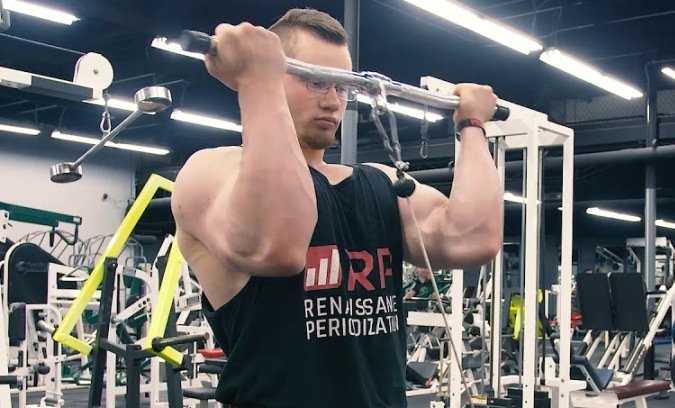
How to Do
- Attach a straight or EZ curl bar to the low pulley of a cable machine.
- Use a wide overhand grip on the bar, wider than shoulder width.
- Curl the bar towards your shoulders without moving your upper arms by flexing at the elbows.
- Slowly lower back to the starting position.
4. Cable Hammer Curl
The cable hammer curl is one of the best exercises that you can do to build your arm muscles.
When it comes to building massive biceps and forearms, the rope hammer curl is an effective isolation workout that targets the brachialis and brachioradialis.
The cable rope hammer curl is a variation of the hammer curl, that is utilized to build the anterior muscles of the arm.
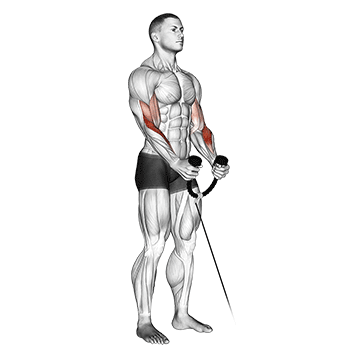
5. Cable Reverse Curl
Unlike traditional curls, the reverse grip specifically targets the brachioradialis muscle, which runs along your forearm.
The cable reverse curl helps to balance arm development by targeting the less often targeted muscles of the forearms and brachialis. This can lead to a more proportional and aesthetic arm.
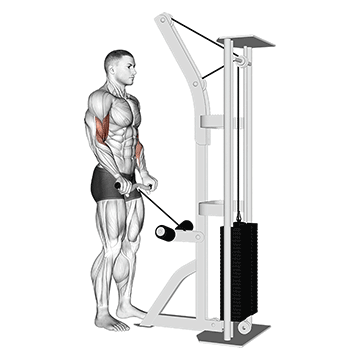
6. High Cable Curl
The High cable curl exercise is a great option that will help you to target the biceps and build width and thickness of bicep muscle.
The high cable curl has two main versions: one-arm and two-arm. Both variations are effective.
High pulley curls isolate the biceps in a wide range of motion and offer the opportunity for high training volume. This makes them invaluable for inducing hypertrophy and otherwise improving the appearance of the biceps brachii.
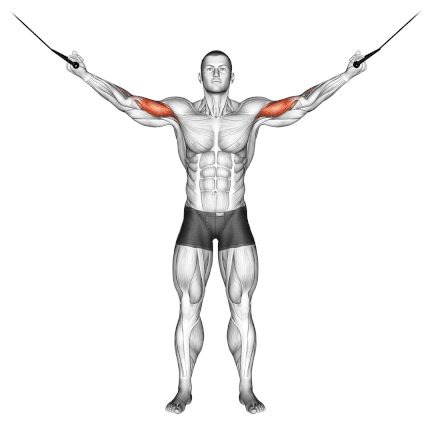
FAQs
Are cable curls good?
Yes, cable curls are an effective exercise for targeting the biceps muscles. They provide constant tension, allow for a full range of motion, and offer various grip variations to engage different parts of the biceps.
Why are cable curls so good?
Cable curls are beneficial because they provide several benefits, including:
- Unlike dumbbells, allow constant tension on the biceps through a full range of motion.
- The unilateral option trains each arm independently.
- The wide range of weights available allows you to progress.
- It is easy to focus on squeezing and contracting the biceps through isolation.
- Flexible hand position options (underhand, neutral, EZ bar, rope, etc.)
- Cable curls are a low-risk exercise, as they do not put a lot of stress on the joints.
Do cable curls target short or long heads?
Cable curls target both the short and long heads of the biceps. However, certain variations, like close-grip cable curls, may emphasize the long head, while wide-grip cable curls may emphasize the short head to a greater extent.
Are cable curls push or pull?
Cable curls are a pull exercise because they involve pulling the cable handle toward the body.
Pull workout engages the back, rear delts, and biceps. In contrast, push exercises involve pushing away from the body. Push workouts engage different muscle groups, such as the chest, shoulders, and triceps.
References
- Nunes, J.P.; Jacinto, J.L.; Ribeiro, A.S.; Mayhew, J.L.; Nakamura, M.; Capel, D.M.G.; Santos, L.R.; Santos, L.; Cyrino, E.S.; Aguiar, A.F. Placing greater torque at shorter or longer muscle lengths? Effects of cable vs. barbell preacher curl training on muscular strength and hypertrophy in young adults. Int. J. Environ. Res. Public Health 2020, 17, 5859
- Coratella, Giuseppe, Gianpaolo Tornatore, Stefano Longo, Nicholas Toninelli, Riccardo Padovan, Fabio Esposito, and Emiliano Cè. 2023. “Biceps Brachii and Brachioradialis Excitation in Biceps Curl Exercise: Different Handgrips, Different Synergy” Sports 11, no. 3: 64. https://doi.org/10.3390/sports11030064
- Ashmore A. The benefits of unilateral training. American Council on Exercise.

Manish is a NASM-certified fitness and nutrition coach with over 10 years of experience in weight lifting and fat loss fitness coaching. He specializes in gym-based training and has a lot of knowledge about exercise, lifting technique, biomechanics, and more.
Through “Fit Life Regime,” he generously shares the insights he’s gained over a decade in the field. His goal is to equip others with the knowledge to start their own fitness journey.

